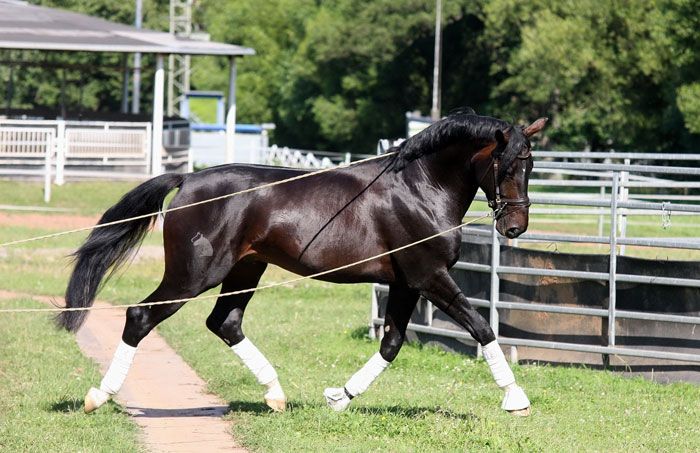Long reining, as with lungeing, really needs a lot of patient practice; you cannot afford to make mistakes, particularly with a young horse. Unlike lungeing, when the rein is attached to the nosepiece and if the horse moves more quickly than anticipated the worst that can happen will be a strong pull on the cavesson, if you make a mistake while long reining, when you are normally attached directly to the horse’s mouth, at best you will jab the horse in the mouth and at worst you can actually damage and bruise the bars and the tongue.
The main reasons for long reining are:
- To teach a young horse to move forward confidently;
- To mouth a young horse;
- To improve the horse’s balance;
- To improve the horse’s carriage and gaits;
- More progressive training of schooled horses;
- The training of High School movements.
There are several methods of long reining and a few particularly good books on the merits of each method and how to do it. You will need to decide which method is most suitable for you and the work programme you have decided on. If you decide on a method that involves long reining from behind your horse then you will need to be very fit and fairly fast as continuous trotting is very tiring! You also need to consider the equipment you use as each method involves different distances between horse and handler and different heights at which the reins are attached to the horse. The length of your reins in particular will need consideration; reins for the English method, for instance, which involves Circle work, may be too long for close work and leave you With a lot of spare rein to hold.
Suitable bits
The most comfortable bits for long reining are half spoon or D ring snaffles as the actual cheek of the bit helps the horse to turn by supporting the signals each rein makes. Also, using a checked bit eliminates the chance of pulling the bit through the horse’s mouth. The half-spoon snaffle has a cheek at the bottom so that the cheek lies neatly below the face which makes it less likely to be caught up in any other piece of equipment.
Long Reins
The length of your long reins depends on which method of long reining you adopt. If you are going to, in effect, lunge your horse on two reins for most of the work on long reins, then lunge rein lengths will apply: 21-24 ft for ponies and cobs and 30-36 ft for larger horses as you will need to use the full width of a school in order not to put too much strain on the horse while circling continuously. If you are driving your horse on long reins by walking behind, then very long reins may be difficult to manage safely.
Material
The material that your long reins are made up of is really entirely up to individual preference. Tubular cotton webbing, cushion webbing and Continental webbing, are all very suitable. Make sure you get the right thickness of rein for the size of your hands, too thick or too thin can mean that your ability to hold the reins sensitively and effectively will be impaired if you are struggling to hold both reins and your whip. Some people favour soft flexible plough lines as long reins, though these are not as easy to buy and are sometimes too short for large horses.
Long-reining rollers
You need a substantial roller if you are going to do a significant amount of long reining. A well-maintained leather roller is best and well worth the outlay but they do cost a lot of money. One or more pairs of terrets either side at the top of the roller are very useful and then a series of at least four D rings on each side is also very useful. If you are going to use the top pair of terrets to put your long reins through you need to position yourself nearer to the horse’s quarters than to the shoulder when lunge/long reining, as it is very easy for the horse to turn towards you and as soon as the reins wrap around the terrets of the roller you lose the ability to guide the horse.
Cruppers
Using a crupper helps to stabilise your roller and keep it more secure on the horse’s back. If your horse is not used to a crupper, introduce it in the stable in a controlled environment so that the horse has time to familiarise himself with the feel of it before you work him outside. Your roller will need an additional D ring at the back of the pad on the top for the attachment of the crupper. It is very important that the dock part of the crupper is kept very supple as the skin under the horse’s tail is very sensitive and can be rubbed very easily; keep a careful check on this area.

